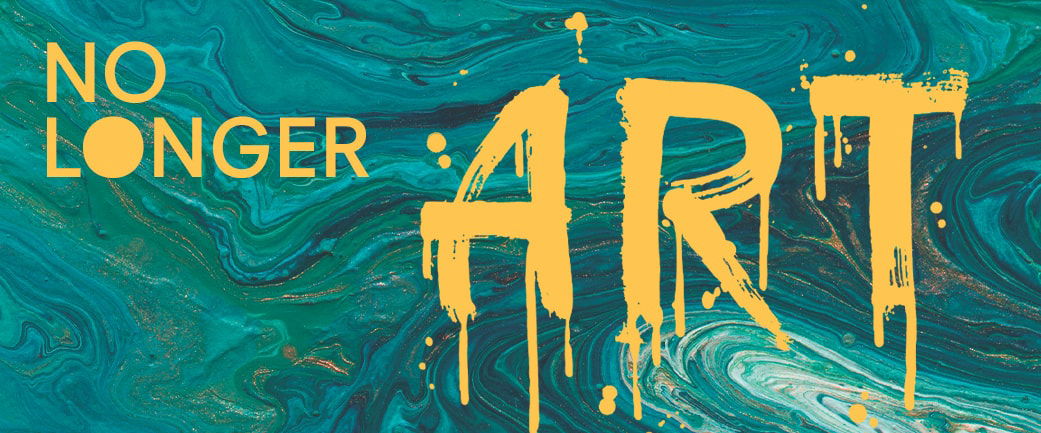


This chapter, along with the preface and introduction, are from a semi-fictional unpublished book, No Longer Art: In a Coma, about select pieces from the Salvage Art Institute inventory.
PREFACE
VICISSITUDO
(MUTATIO)
((NOVO))
A large, painted-steel sculpture versus its recovered parts transformed due to direct impact and fire, warehoused in an insurance company storage facility, New York City
The following is a comparative list of qualities of the original against its recovered parts:
| Before the Impact | After the Impact | |
| COLOR | ||
| Custom red by Keeler & Long, Uniformly distributed | Post-burn ash grey, pale orange, rust brown, distributed in irregular patches | |
| SURFACE | ||
| Smooth, flat, reflective, with minor irregularities along the edges | Porous, with soft-bends, flaky, dust covered in parts, with visible abrasions and gauges | |
| MATERIAL | ||
| Carbon steel and Poly-Silicone Enamel from P-Series (20%-30% copolymerized silicone-alkyd) | Burned steel, oxidized paint, ash and debris | |
| DIMENSIONS | ||
| One solid: 45 feet x 15 feet by 20 feet | 3 fragments 40 feet by 5 feet folder over one another, fused in parts | |
| OTHER DISTINGUISHING MARKS | ||
| Evenly distributed rivets along outer edge, signature on the inner edge | Holes and partial rivets, no signature |
Here lies a proposition that such transformation in an artwork’s qualities, if legitimized by a formal declaration of a total loss of value on the marketplace, initiates an autonomous state of matter. This temporary, no-longer-art condition of material, released without intention due to accidental and “total” damage, gains its autonomy through a statement issued by the art insurance industry, a final pay-off to the insured, official transfer of title and the sheer fact of inventory and storage.
Here unfolds a guided redrawing of links between artist’s pronouncement of an artwork and the issues of authority and agency of voices declaring it obsolete.
When I arrived at an art conservation studio and saw “the corpse”—smears and clumps of chocolate stuck to its plexi-box-container and irregularly broken pieces accumulated at the bottom edge—I thought I could simply take it. I was thrilled by its useless, demoted state, its orphan stance, its loss of ambition and almost erotic, glaring nakedness.
But soon I found out I could not take it, and that though worthless it now belonged to the insurance company who as its new owner had right to its future.
A statement of loss, or a final proof of loss, issued by an insurer legitimizes the findings of art conservators, appraisers and adjusters. It announces the formal stripping of an art object of its value in the art market and effectively its status quo as an artwork.
The reasons for this stripping through devaluation seem to range from extreme physical destruction to a strictly subjective feeling of a claimant who, on account of damage, has lost her heart for the work to gain the total refund.
How does this unintended damage beyond repair push an artwork past its limits, beyond an ability to speak for someone? Because it has lost the relationship with its master and its audience, it splinters in all directions in so great and disparate configurations, and through multifold alliances that, in extreme cases, it actually resists to be seen.
Material freed from artist’s pointing finger, bending it backwards into non-creation is a rare substance in contemporary times overstimulated with art-making impulse. It surfaces as radical and unexplored and is somewhat hostile to interpretation due to its unintentional, traumatic beginning. It assumes a deregulated form in a legitimized, industry-regulated zone.
INTRODUCTION
I am in a coma and what you are reading has been carefully absorbed and transcribed by two very empathetic and committed souls, who availed their time and their brains to be by my side for months and make a record of my otherwise unseeable flashbacks and visions. This report, though it might seem condensed, is a result of an intermittent recording and transcription process. Some words might seem out of place, uncomfortable. I request to let them be.
Linda and Pipo were chosen for the transcription task because they are artists whose beliefs reflect my deep commitment to art and my personal despair about its place in western celebrity culture. I am not saying their wording is exactly mine, but it is as close as current technology allows. I am willing to take the risk and allow this experiment to be public. You need to understand, art is my religion and from the place I am at, art provides the only way out.
Though comatose, I am still very alert to my immediate environment and my brain remains fully receptive and capable of creating complete sensory experiences. We are concerned here with drawing them out. To stimulate my brain’s transmissions, every two weeks, Linda and Pipo would bring into my room an object from my salvage collection vault. These are former art objects that I had retained from total loss insurance claims. I have had many years of experience in the business and accumulated quite a substantial lot. Linda was in charge of choosing the objects she thought would stimulate my brain the most. The couple patiently waited for each object to emit its presence and for it to arrive into my subconscious, exciting my brain into feral activity. The whole procedure was conceived partially as my treatment, to give a personalized mental massage to my brain cells, and in part to test, and befriend, an advanced brain-machine interface which networked them with me, and with each other.
The protocol for the sessions was consistent. Linda would announce the object’s presence in the room and its comprehensive inventory code—I have invented a system of naming these objects that reflected their material history of loss—and Pipo would read out selections from the available documents associated with the loss claim. Linda would carefully, yet directly, handle the object and describe its current condition, then both artists would be hooked up to the brain interface and wait for my broadcast. They took notes independently to assemble and arrange them later into a legible enough account.
Our sessions became like clairvoyant séances, but instead of looking into the future, we were looking into some vivid flux of future, past and techno-chemically concocted, illuminated present. A world where what was once deemed worthless accrues a different state of ontology and opens possibilities of experience, particularly of art, much richer than the confines of our ritualized relationship to artworks allow.
You will soon realize that the content of my transmissions drifts from the collection per se. The impressions I pass on are no longer dealing only with the provenance or claim history of the objects, but bring in all my emotional and monetary investment as well as mythical beliefs I had admitted to through saving those objects from market circulation. After all, I have been giving shelter to worthless, disgraced, kicked-around things because I see in them a potential I can’t see anywhere else. They confirm for me that I am standing on the ground, that I am alive, here amongst you, and that all of it matters.
SESSION BEGINS (log follows)
SAI = Salvage Art Inferno
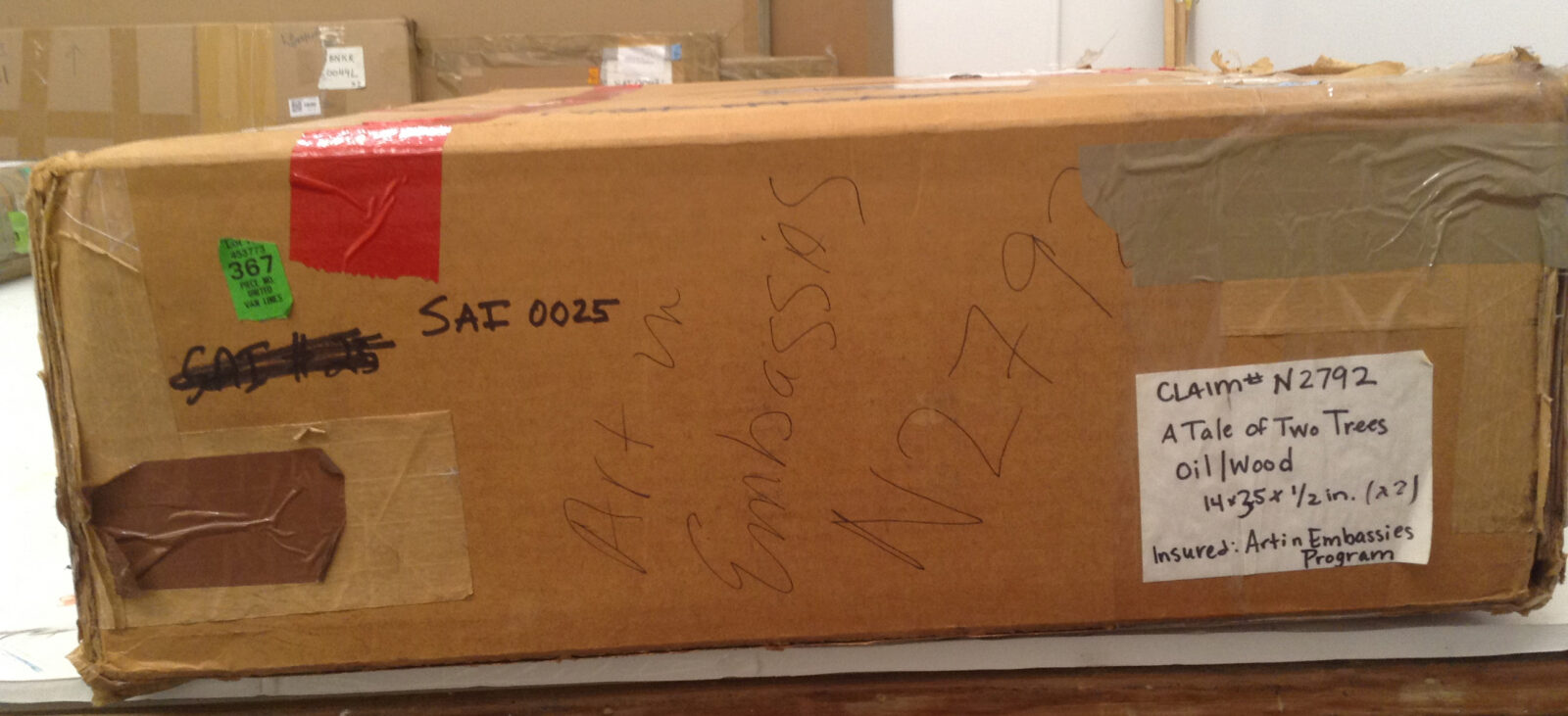
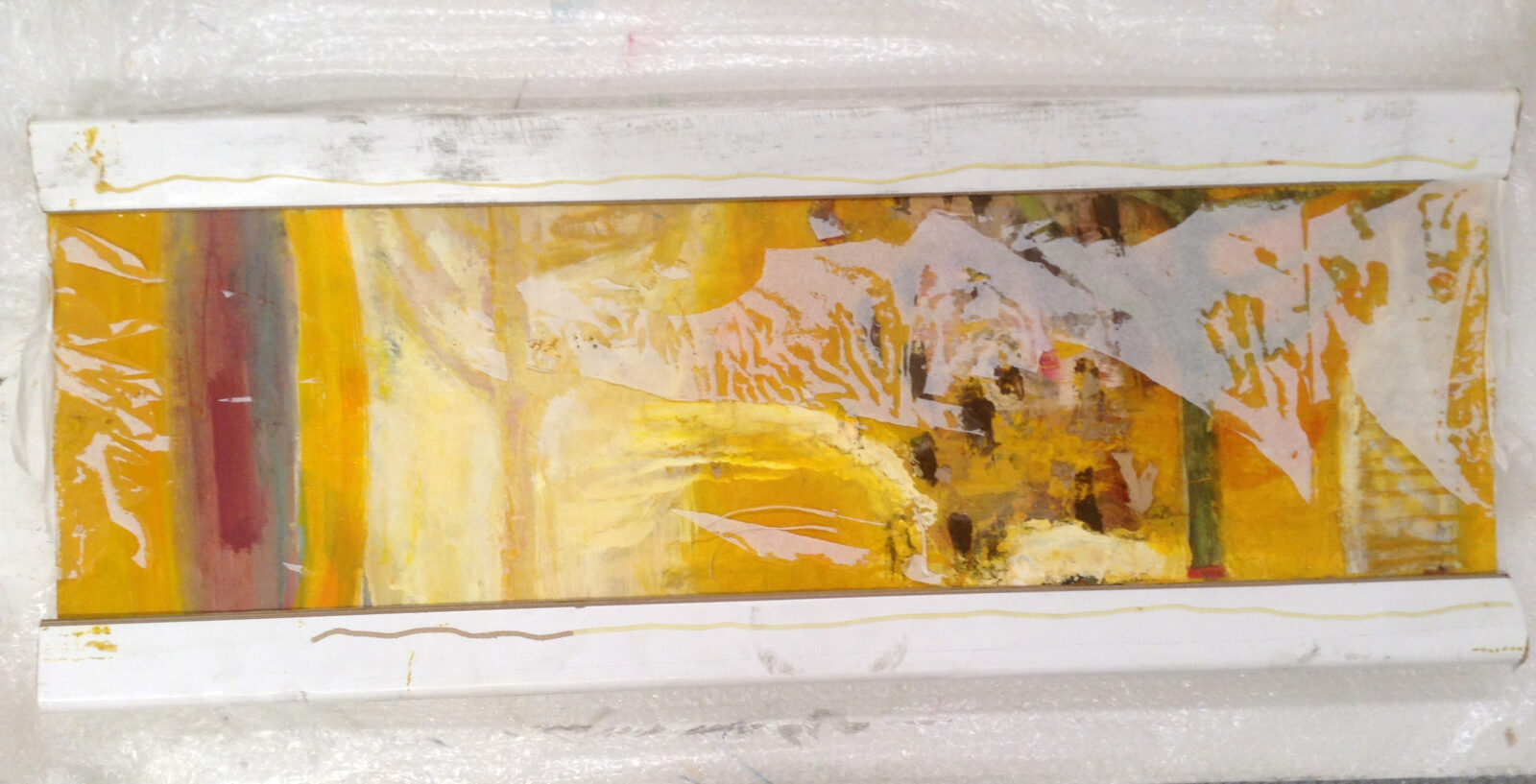
[Linda and Pipo bring in the package and set it on the table: a painting that is still in its box and wrapping. Linda is having trouble closing the door. Pipo initially tries to help but smells something unusual and decides to leave the door slightly ajar.]
Best if we prepare the room a little for this one. Make some extra space, dim the lights, turn off all unnecessary noises and friction.
[pause]
[Linda and Pipo fuss around the table, among sounds of rustling of paper, tearing of tape, and bending of cardboard.]
It is going to take a while to get around this, what one could call a painting. We shouldn’t rush. After twenty-seven years the paint is still gooey and literally sticks to everything that comes in contact with the surface. We are having trouble unpacking it and unsticking it from all the protective tissue and cardboard. We are going to leave some of it stuck not to damage the painting further. There is now orange paint on everything. It looks like some parts of the painting were coated with resin varnish and the thick paint underneath never dried. I will add a note about varnish to the code.
Here is the updated code:
SAI 0025: materials: oil, resin varnish, plywood, wrapping; size: 14 by 35½ by 2 inches and variable; damage: unknown, packaging stuck to painting when wet; claim: unknown; total loss: unknown; production: 1992; artist: Duane Slick; title: A Tale of Two Trees or Two Trees.
We have no official paperwork for this piece except for the entry in the deed of gift and a condition report from 2015. There are also material indications, on the box, of where the item has been. There is a label from “Art in Embassies” program and some handwritten insurer’s codes. Here is the condition report.
[Pipo reads the official condition report.]
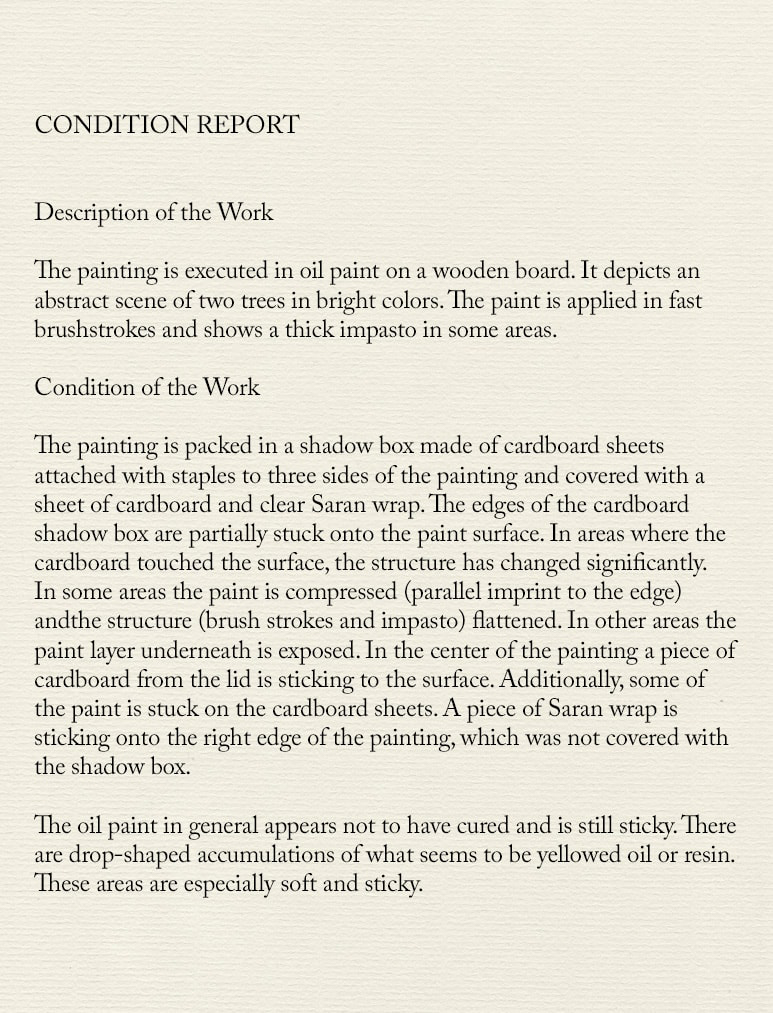
It seems like every time the painting is being packed and unwrapped it continues to have relationship with packing materials.
[Linda piles soiled tissue and bubble wrap onto one side, sets pieces of paint-smeared cardboard by the table, and sets the painting at a slight angle to look at the sticking varnish areas against the light.]
I am confirming that all varnished sections of the painting are still soft to touch. The paint that came off onto the tissue is still sticky. The plywood panel on which the image was painted has a horizontal crack, about three inches long. There is a lot of tension and movement here, just of materials themselves. There might be an additional, underlying reason for this. I read that the artist identifies as a first-generation urban Indian, born of a father from the Meskwaki Nation in Iowa and a mother from the Ho-Chunk Nation in Nebraska. Both cultures have profound relationship to source materials, wood, resin, nature in general. We might need to be aware we are dealing with untraceable.
I will light a few candles, so we allow shadows to form and so we may become aware of wider presence.
[Linda looks at Pipo with surprise then awe. Pipo finds candles and lights them in the two corners of the room. Linda slowly tries to remove some more loose pieces of wrapping from the surface of the painting. She brings a piece of resin-coated cardboard, puts it over the flame, and examines it closely.]
I am confirming that what has been applied over some parts of the oil paint is natural resin. I can smell it. Resin is really the original incense as most comes from refined tree sap. It has been used mainly in spiritual and religious ceremonies and some pagan practices, as well as being used in mosques, temples, churches, other worship places, and homes. I will put off the smoke. We don’t want to activate the fire alarm here, but I wanted to acknowledge the smell.
[Pipo takes the resin-stained piece of cardboard from Linda and turns a soft spotlight over the half-unpacked painting.]
“When the ground shifts it tends to produce solidarities, affinities, filiations, attractive mirages, at least of magnetic field”—Jacques Derrida, On Touching—Jean-Luc Nancy
[quotes]
“Find tongues in trees” —Shakespeare
“one gapes at a painting / the other waits for mahana” —Julian Talamantez Brolaski
[Transmission begins][Transcription begins]
log 25.1
Careful, wet paint. Of wetness. Of being moist. Of being a moist organ. Of being amongst moist organs. Of resembling a cosmic womb. Of the shifting of states. Of leaving marks. Of leaving traces. Of being sticky, of fluid state that signals opening, incompleteness, endlessness. Of finding a relief in it, a reconciliation. Of coming from mud or of coming from marshlands. Of viscosity. Of dampness. Of maintaining wetlands. Of feeding. Of nourishing. Resembling a well. Of fullness. Of wet walls in early spring. Of frescos in the naves and of shadows. Of puddles, of wet cement before it hardens and the warmth it produces, perceptible to touch. Of sticky fingers, of stealing. Of touch and touching and touch ups, while wet. Of pleasure and of seeking. Of rivers and rivulets running down, of tears. Of being able to be pressed permanently out of shape without breaking or cracking. Being malleable. Alchemy of wetness, of fertile ground. Of mud in the veins.
Do I, or if I, dare come near.
Whatever entered has multiple spirits attending because, well, our blood is not pure after all. Too many violent rapes proceeding us, mud in the veins. Yet still, important to hang ornaments in the orchard, light a beacon on top of the stack, attempt to reconcile what’s been left behind and what is waiting. This thing or person wants to be present, and it wants to spread.
log 25.2
The world is liquid, inside and outside of us. The earth is liquid inside itself. When matter liquefies it’s in preparation for a change of state. To shift and to transform. The sky pours into the ocean, and the ocean pours into creatures that inhabit it, and matter returns to slime. I watched my father liquefy before my eyes. It took him seventy-five years, yet then, so slowly, through tubes attached to his insides he started to come outside and his body let me witness it. Brown, yellowish sludge rhythmically pushing air bubbles out as it advanced. It was calm and mysteriously simple. Gradually shutting down his organs, brain first, then the eyes, then the grip on my arm loosening. His chest slightly caving in. There was no drama, just a single wet tear running down his cheek. Liquid reconnecting him with the rest of the world he so strongly struggled to keep away. There should be some respect around a liquid state, some recognition of its magic. Same as with sleep perhaps. A liquid and a sleeping person, human or animal, are holy. They emit a force that recalibrates the universe.
log 25.3
To prepare the space for transformation. Maintaining the wetness for the purpose of inviting the materials to merge at will and also to take on new forms, interfere with the surroundings. Invite the immediate. A wetness of this sort, this sort of exceptional humidity, does not only affect the hand but it relocates with everything that comes near. Wet surface that never dries points to a maternal embrace.
Underneath the tree a red flame. Nothing grows without a little bit of destruction. With a dose of proper channeling, not property. That living demon of ruin goes up and down and up and does not get rigid or heavy. Hoping to resurrect, waiting in the bushes, wet.
log 25.4
Once the interior is prepared, and corners stoked, and oven on, and those who choose to play children step forward, the rites begin. Silence around.
log 25.5
Each day she wakes up to touch a wet part of her body. A biologically necessary product of commingling of belief and art. She waits to gain a respect for an image.
Connecting us to the cosmos. Vertical inside horizontal through surface and paint. Honoring slowness of cautious animal movement, pacing.
Looking at the trees of mother’s memory of grandmother’s experience. Wisdom and foolishness of the elders.
What is the belief? That the intelligence is much greater than any history has imagined, and creating conduits to this intelligence needs aliveness and singularity of failure and group dynamics, all in synchronicity?
log 25.6
The ceremony begins. No clear sign but an atmosphere from constant dripping, the humidity and the accompanying tones. Energy shooting from star-like points, from black moth-like stains and smears. Soot-like. And upwards from the horrors and humiliations of male, perhaps rotten, deals, towards women, perhaps, or fingers, branches, sticks, and beyond.
The yellowish glow, flowing, retarded, like cooked straw, straight up and down.
Hello, yellow and orange look good on them.
[Longer than normal pause. Linda returns to touching the painting.]
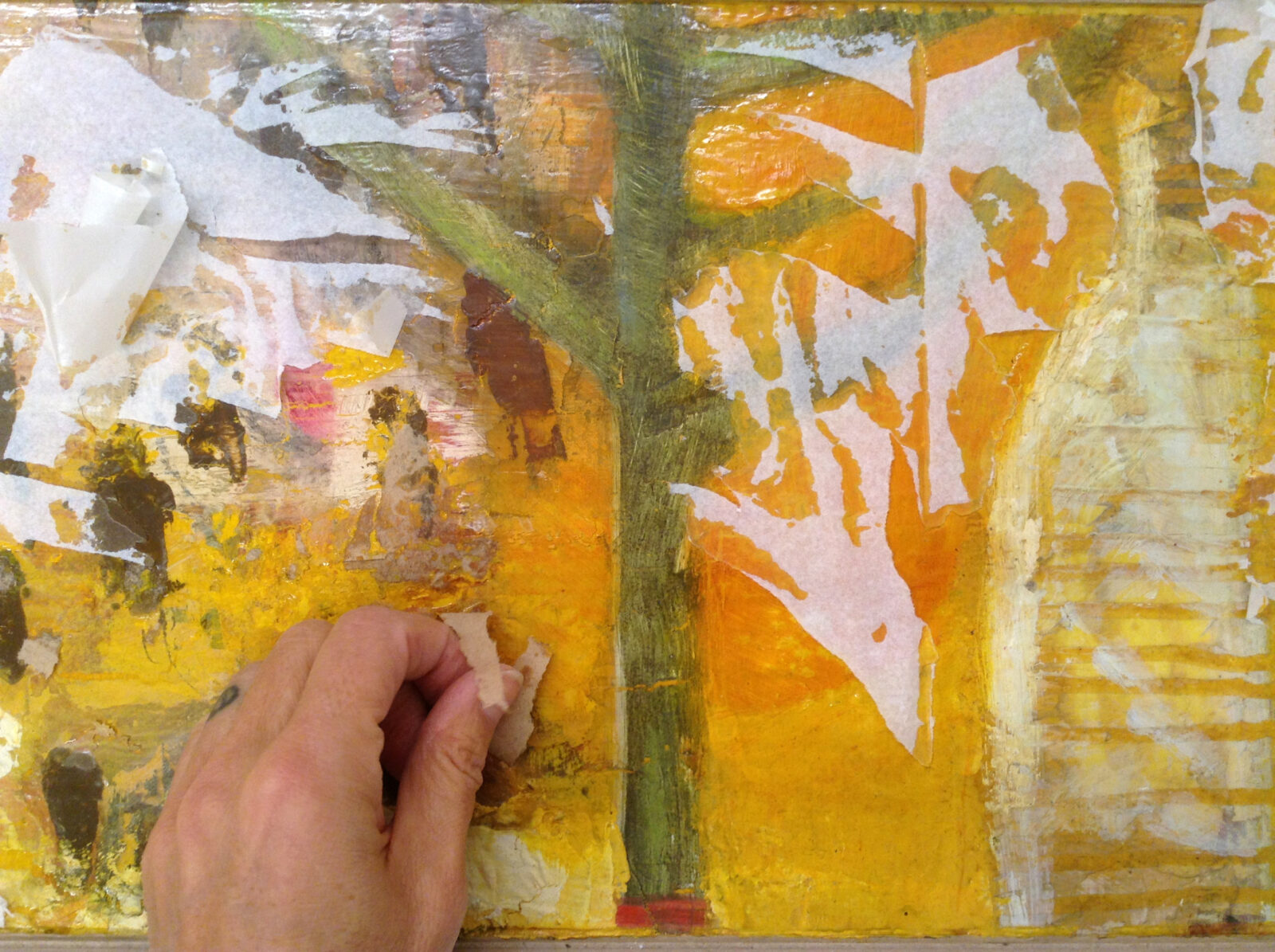
I tried to cover the mess a little, peeled away the excess of tissue—wrapping tissue I mean—pried away the tough cardboard edge. Edge like part of a stubborn wall. But in a sense to no effect: the cardboard curls back, new tissue, bits of Saran wrap sticking again. Only more and more vulnerable, exposed.
How about if we leave it out, laid out like this, breathing, for a while in the room air. Or maybe even find a permanent open space for it so its conduit, the passage, continues to extrude, continues to click grasping for air for as long as the walls stand.
It’s a dying body. Time stops. If you anticipate a clean resolution, stop right there.
[Transcription resumes]
log 25.7
You are like a continuous gift. Unconsumed, half closing, part opening (very slowly) like a never-closed deal. Not quite clear how much time we have for this. For this “duration,” for the pleasure of not seeing yet fully.
City rains come. Feeding corner molds, vapors between panels, sheet fumes, feeding gutters. Collecting in pools around crooked drains. On the one hand how horrible to leave you out like this. Half unwrapped.
log 25.8
Speaking in tongues. The halo of loosely attached, connected, hovering words. Between a talking stick and a prayer rod. A painting, active like this, exudes radiance before it turns to ash, before wood becomes black soot.
log 25.9
Dampness attracts. A human moth crowd circling then approaching, clustering around the water table, near the surface of the well. Marking out estuarine territorial membranes, marine currents taking them out and in and out again. Dampness attracts poets. One comes to my house, grabs a microphone, and poses, leaning, in the doorway. Then pulls out two cards from the deck: Justice and Le Soleil, for the end of rain.
Dampness attracts. Breath and moisture from breath. Breath is damp and dense like a winding snake. And a snake is, if carried upwards, like a trunk of woods, wood.
log 25.10
Skins. Cyclically, as the time turns, in the most wet areas, the paint gradually grows a thin protective skin. Airing. Curing but not healing. Until it is disturbed again. A temporary membrane acting as a mediator between humans and trees. Similarly between this world and bigger world, the bigger world containing all possibilities of intelligence and organizing of that intelligence. Various orders.
A shimmer of gold catching the eye, of orange color seducing butterflies and capturing lonesome birds. Dizzying heat of sun rays, warmth of the hearth pulsing through the air. Of pools of sticky honey on a plate. A trap.
[pause]
[Transcription resumes]
log 25.11
It’s a dying body. Time stops. If you anticipate a clean resolution, stop right here. All there is to be done is to take care of it, and each other, in this space. Put proper things in their proper place. Recognize the corners of the world, align your inner North with any faraway star and the entrance to this space; East with pale yellow glow and dampness of the surface of the Earth and the stickiness of the paint; South with depth of your feelings, or acknowledging where you belong, of your internal home country; West with incoming darkness, crows spaced like dark dots in the field.
Minute after minute, things fall apart. Crumbling, liquefying, cracking. Slipping, the sliding of skins, of surface against surface.
log 25.12
A body brought in to die slowly in peace. Renouncing clocks, bringing down the lights. This continuous dissolving, prolonged expiring. The space of what it makes in time, around an object, a person, a personal object. Lasting, expansive.
Have you ever had a relationship with an animal? Not necessarily a pet. You know when your animal comes close to you to die? Returns to you, flutters her eyelids, sinks deeply into your side, changing in temperature, their alignment. Waits for you to catch up, like a single living cell embraces your body in diminishing tenderness.
Trees, grasses, rivers, buildings like trees surrounding, closing in. Drawing life-will out of you, helping you mourn along the way, making the mourning path.
log 25.13
In a certain house they bring in the body and surround it with candles or flames.
In another house they surround it with smoke, incense where ribbons of fragrant vapors can together twirl upwards, rising. Slow refusal of drink and food, paced closing but equally opening and letting all go into dissolve. Smoke turning into moist mist.
In yet another house they let the body stay in darkness. They bring vessels of water and through the absence of light guide the body to return to a state of a chosen aquatic animal. Others still forgo the house or tent and raise the body onto a platform or place it in a tree, about eight feet above the ground and take turns guarding it.
log 25.14
Liquidity eases trembling. It somehow glues the otherwise disruptive tremors. In a space where afternoon falls over with the and the body splinters into rattling tiny motions, the glue arising from moist air softens and slows all movement.
log 25.15
She holds a cup, very gingerly, thirsty from a day in the fields, her hands still dirty from day’s work. A princess in the fields, gathering cow dung, used among her clan to fire up the stove, has exhausted her back and strained her royal arms. The basket previously mounted on her back and the stick with which she worked now lean against the tent. Her land has no trees and as far as you can see grass and pebbles curve the Earth’s horizon. This is the steppe, the steppe of her ancestors, the ocean of grass from where they bred, among trees in dreams.
Let us return to the dark woods of her memory. The “W” of her flashbacks as a girl making her way through the thicket without seeing a clearing. Various details make her move, time passing and the darkening of the sky, the cold, the hunger, the longing for familiar faces, the need to exchange, converse, and gather.
The story goes that people in her village painted their trees, the tree trunks measuring from the ground up to the height of the tallest members of their community. This served as both protection of the tree from harsh sunlight but also to announce to the neighbors the agility of their women and their empire.
log 25.16
You open the door and it’s not one thing, it’s five hundred things rushing in. Restlessly flooding through in no particular order, as if blown in with the nor’easter. Lives after lives, the container of space it opens, bird sounds pour in, including the extinct birds, those that already flew off the branch forever. In millions.
Perhaps it is enough that we bow our heads in the direction of the weakest link in our social chain to recognize the materials it is made of, the mineral compound of the earth and all solids and content of the water drunk, all the way to the intentions and attitudes of our neighboring strangers.
log 25.17
Diving in with our eyes trying to make sense of what and how, and which way to proceed. The senses mingle, what you stare at suddenly clogs your throat, stains your fingers. Oddities clambering for recognition.
log 25.18
Where does the fear come from if not from the unfinished business: ancestry, pedigree, parentage, genealogy, family-tree truncation.
This particular family history spawned multiple family trees. The old women, the great-great-matriarchs making sure that the walnut and the cherry never touched roots. She dug a hole in the ground to find a position for a home, not an apartment, not a building per se, just a place where she can extend both downwards and up. Digging is hard in the city. The dirt obscures the chemical imbalance of everything, but it does reveal histories of neglect, of misuse. She lets the sun shine on her feet, flooded by sunlight. She disregards shards of glass and stones pressing cold into her toughened skin. She recognizes the persons around her, the shrub, upturned bucket, coils of metal wire, sheers, an axe. She bows her head and coils her hair. She braided her hair twenty-seven thousand evenings before she let it be cut.
log 25.19
An unfinished work resists evaluation. One cannot appraise something that has not taken its final shape, because the evolving value would need to be contractual. It refuses to be commodified, cannot be fixed. It continually opens to the audience, to itself. It challenges its maker continually postponing its abandonment.
No maintenance will settle it, no axe will freeze it.
log 25.20
Have you noticed that big trees tend to stand near slaughter places as markers for massacre. We are all half breeds from a man of violence and a woman of shame.
log 25.21
The Western cultures point to closure as a way to resolve the past experience. Other traditions, however, emphasize openness and readiness for contact and reconciliation. There is justified caution around an object that is alive, moist but not necessarily of human or animal origin. That caution must relate to profound, primitive experience. The aliveness confronts with watchfulness, requires recognition. Liquid cells are in the end in motion both on the molecular and apparent scale. This thing might be moving towards you or away, making you constantly want to wash your hands.
log 25.22
Families fleeing war tend to carry with them very little. This explains empty pages in the photo albums, or no presence of photo albums, or general chaos in memorabilia. Maintaining lineages requires mental health and strength of spirit and beliefs.
Among loss, suddenly arbitrary objects are endowed with special powers, no longer a family icon or heirloom but a plastic dog from a dime store, a sticker from a congregation.
log 25.23
We gather to face and recognize one’s elders without pushing our story upon them, recognize fear and shame equally to bravery and foresight. Old methods of annihilation of the weak and old, that have taken over multiple civilizations, obliterate an opportunity to realize ourselves. There is room for rage.
log 25.24
My mother leads me with her pictures. I follow. Over and over, she paints space between two trees. Over and over, different hues in different saturation, clashing and harmonizing colors, afternoon and night. Over and over, branches and trunks bending around a tunnel-like space at the end of which something very simple and sort of obvious emanates. Not a mystery per se but light deliverance. Hidden in the wetness of the temporary skin, showing exactly because it is fragile. You will be betrayed and will be betraying regardless.
log 25.25
Here we meet on a ceremonial ground. Your willingness not to slaughter me within minutes is recognized as a priceless gift. So we proceed and we stand ground. Here is what I can offer.
Considering that our previous generations have witnessed profound cruelty amongst each other and towards all surrounding living organisms, and that they had not skills nor tools to process or transform them, you need to let those cruelties surface in your lives. Instead of attempting to wash them—the stains that never go away—or even worse, domesticate them, the acts of cruelty need to find their transformation materials and a place of equilibrium. They need to be revisited, understood, and recoded through acts of love.

Elka Krajewska is an interdisciplinary artist and experimental filmmaker. She is also the president of the Salvage Art Institute, which she founded in 2009 to articulate the nature of artworks declared “total loss” by insurance companies and officially removed from art market circulation.
Get the latest news and stories from the Rubin, plus occasional information on how to support our work.